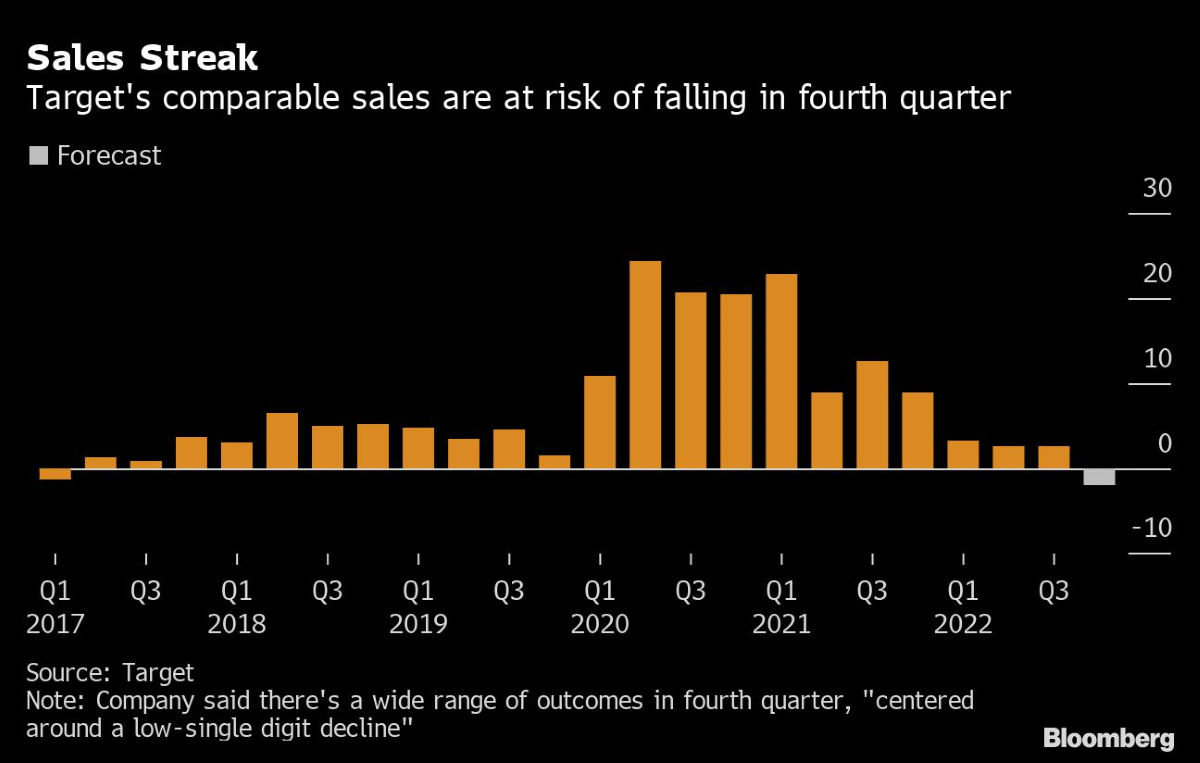
Visit Our Sponsors |
|
|
|
|
|
|
|
|
|
|
|
|
|
|
|
|
|
|
|
|
|
|
|
|
|
|
|
|
|
|
|
|
|
|
|
|
|
|
|
|
|
|
|
|
|
|
|
|
|
|
|
|
|
|
|
|
|
|
|
|
|
|
|

Photo: Bloomberg
Target Corp.’s shares tumbled after the retailer warned in its latest earnings report that U.S. shoppers are pulling back, slamming profit and dimming the outlook.
Adjusted earnings tumbled to $1.54 a share in the fiscal third quarter, the company said November 16. That was below the lowest analyst estimate.
For the current quarter, the company is planning for a potential drop in comparable sales, the first decline in five years, and predicts operating profit will shrink to about 3% of revenue — roughly half the previous forecast. Target also unveiled a plan to save as much as $3 billion by streamlining operations, but stopped short of mass job cuts.
“In the latter weeks of the quarter, sales and profit trends softened meaningfully, with guests’ shopping behavior increasingly impacted by inflation, rising interest rates and economic uncertainty,” Chief Executive Officer Brian Cornell said in a statement. “This resulted in a third-quarter profit performance well below our expectations.”

The report is likely to fuel new concern about the economic health of U.S. consumers, who have been squeezed this year by the highest inflation in four decades. While Walmart Inc. reported upbeat results for the same quarter, much of its strength came from market-share gains among higher-income households, as more shoppers traded down in search of lower prices. Target’s outlook suggests it’s having more trouble keeping up.
The shares plunged 15% to $152.10 at 9:37 a.m. in New York November 16, after sliding as much as 17% for the biggest intraday decline since May 18 — a day when Target also cut its profit forecast. The stock slumped 23% this year through Tuesday, worse than the 16% drop in the S&P 500 Index.
“Perhaps the most distressing part of Target’s miss and guide down is the comments concerning sales trends,”
Michael Baker, an analyst at D.A. Davidson, said in a note to clients. “In some ways, this calls into question what we learned from Walmart [November 15], which was that the retail environment heading into the holidays was solid.”
Part of the difference with Walmart is probably due to Target’s greater reliance on discretionary items, where demand is weakening most. Target said it was planning “for a wide range of sales outcomes in the fourth quarter, centered around a low-single digit decline in comparable sales.” That would be the first decline in the key sales metric since early 2017.
The difficulties will linger into 2023, Chief Financial Officer Michael Fiddelke said in a briefing with reporters, without offering financial details. The goal of Target’s long-term efficiency plan is to save $2 billion to $3 billion over the next three years, and the company is re-examining everything from how it acquires apparel to how it handles digital orders.
“We’re not planning layoffs,” he said.
In the third quarter, operating profit totaled 3.9% of sales, Target said. In August, the company had forecast a range around 6% in the second half.
Revenue climbed 3.4% to $26.5 billion, topping the $26 billion average of analysts’ estimates compiled by Bloomberg. Comparable sales rose 2.7%, while Wall Street had predicted 2.5%. And Target said it won market share in terms of units sold in its five major merchandise categories — an important yardstick in times of inflation.
Profit Drags
The Minneapolis-based retailer also made progress in clearing out bloated inventory, Fiddelke said. But it did so in part by marking down prices more than expected, dragging down profit.
“We think there’s risk of another round of heavy markdowns following the holiday season,” Bloomberg Intelligence analyst Jennifer Bartashus said in a report.
Additional blows came on two other fronts last quarter. One was the cost of managing inventory that arrived earlier than expected as supply-chain snarls improved, a problem Fiddelke said he welcomed as preferable to last year’s shortages.
Another came from shrink, which is retail-industry jargon for goods lost to theft, damage or administrative error.
The CFO declined to specify how much was due to stealing, but said shoplifting has been getting worse. Target said it has taken a hit of more than $400 million so far this year from shrink.
On the sales floor, meanwhile, the pressures on Target’s profit show little sign of easing. Shoppers have become increasingly reticent to buy goods that aren’t on sale, said Chief Growth Officer Christina Hennington.
They’ve also been shifting their spending to private-label goods and smaller pack sizes — or larger sizes that are on promotion.
While food and beverage sales have held their own, discretionary categories such as home items, sporting goods and toys have lagged. Target’s comparable-store sales peaked in September and have been falling since then, Hennington said.
“It was a precipitous decline,” she said in the briefing.
RELATED CONTENT
RELATED VIDEOS
Timely, incisive articles delivered directly to your inbox.






